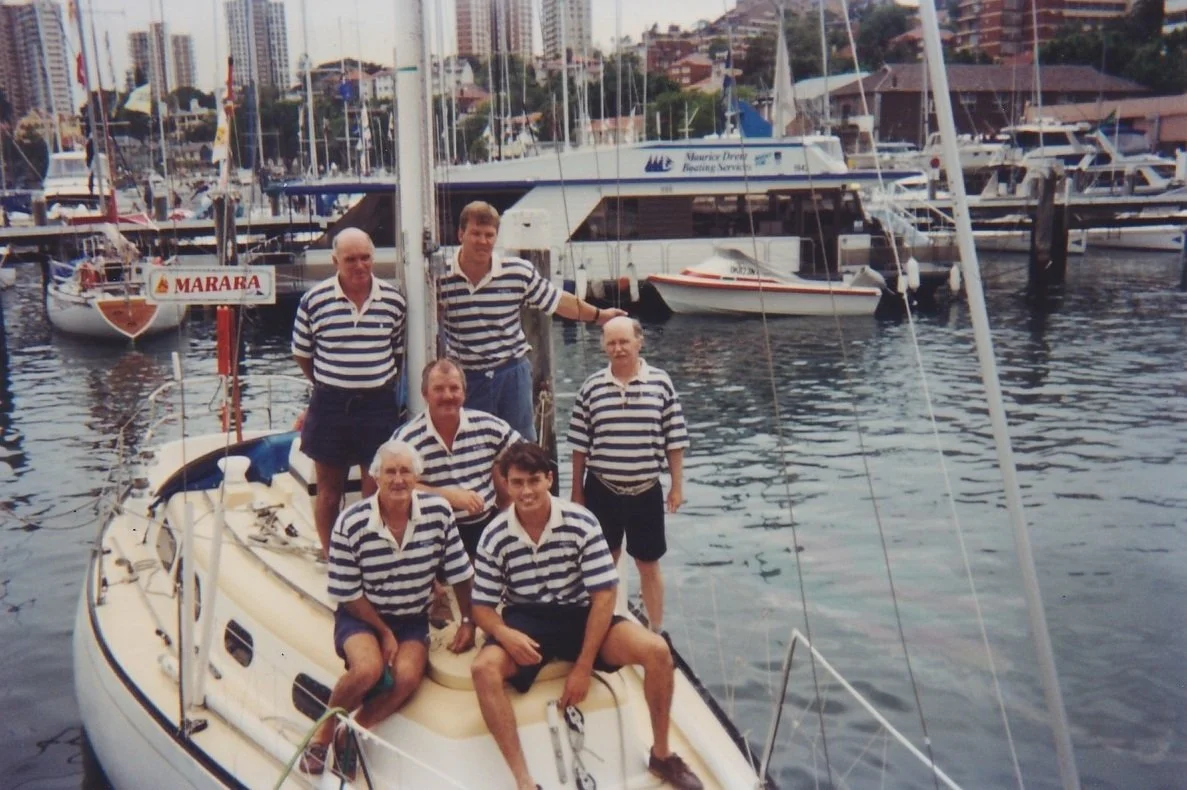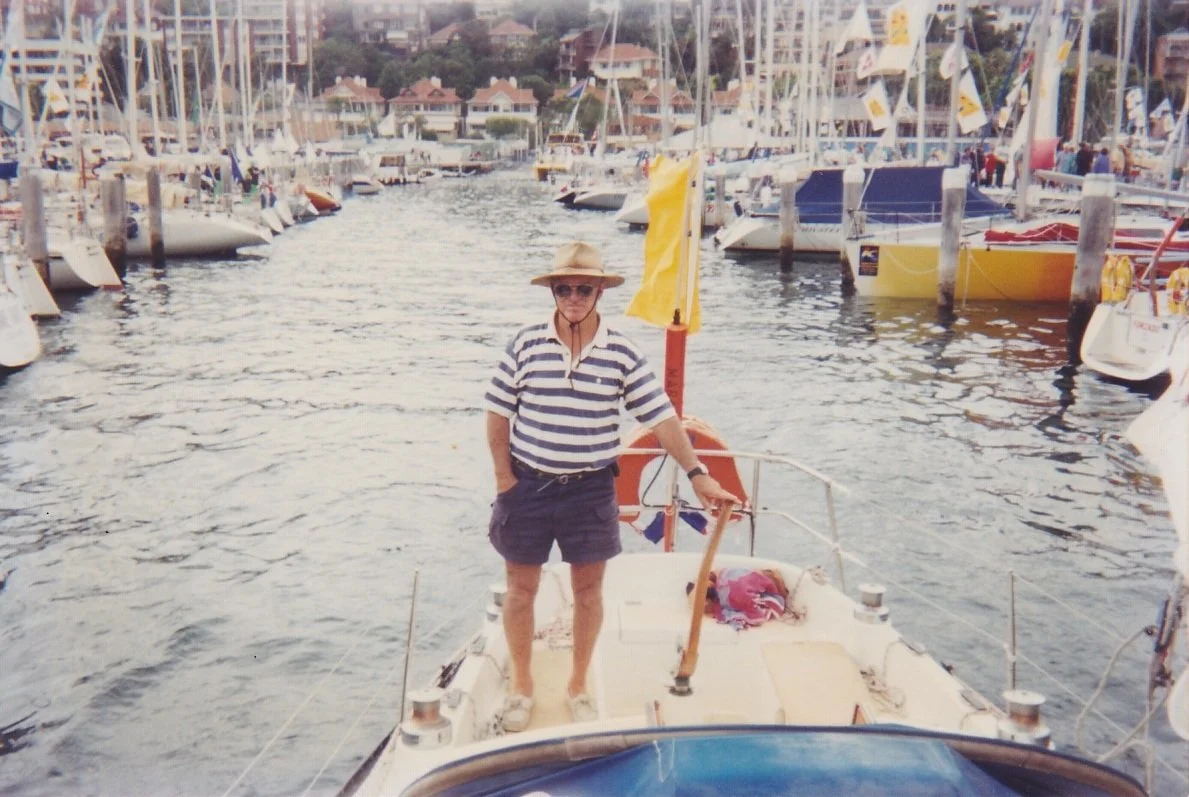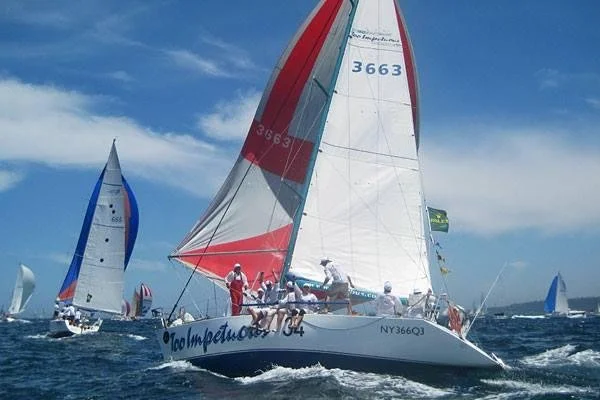The MARARA Story
By John Maddox
Some yachts have predictable lives, never sailing far from home. Others have adventurous lives, surviving dramas and dangers. Marara is one of the latter – to date, three dramas have occurred on board.
Built in 1973, she is a Sparkman & Stephens 34 – solid, seaworthy and still a popular class. Edward Heath won the 1969 Sydney Hobart Race in his first Morning Cloud, an S&S 34, the year before he became Prime Minister of Great Britain. More recently, Jessica Watson was only 16 when she completed her circumnavigation in May this year aboard S&S 34 Pink Lady.
Marara set off on her second Sydney Hobart Race in 1975, at which time she was owned by Alan Murray and Barry Vallance. They had changed her name to Zilvergeest 3, as Alan had success with Zilvergeests 1 and 2, and I had been invited to join the crew. We were doing well on handicap until we reached the entrance to Hobart’s Derwent River, when as usual the wind died as we neared the eastern shore. There was absolutely no wind and the current was taking us near the rocks. We could have started the engine and been disqualified, but instead chose to push ourselves clear with the spinnaker pole, with one crewmember was standing waist deep on the rock shelf holding us off.
While this was going on Barry, who was navigator, said that ‘he was not feeling too well and would go and have a lie down’. When we did get sailing again Alan called down to Barry to give us a course but received no reply. Steve Kingsland went below, to discover that Barry had died during the half hour it had taken us to get sailing. We tried to do mouth-to-mouth and chest pumps, but to no avail. When the medics arrived in a speed boat they said it was a massive heart attack – although only 54, Barry was overweight, had only just stopped smoking, and could have had the attack mowing the lawn. He had been a bachelor, with no wife or girlfriend to tell him to get medical check-ups. Despite this we all felt guilty, thinking that perhaps we should have checked on him while getting sailing again. The only damage to Zilvergeest 3 was a few scratches, when we drifted back on the rocks while trying to revive Barry before starting the engine.
Alan bought Barry’s half-share of Zilvergeest 3 from his sister in New Zealand, continuing to race her while the estate was finalised. I had a young family, so in 1976 and 1977 I flew down to Hobart and sailed the delivery back to Sydney on with some of the racing crew.
Sadly Alan died of cancer in 1980, and Zilvergeest 3 was bought by a good sailing friend, Bill Ratcliff (we had crewed together on other yachts). Bill changed her name back to Marara, as Zilvergeest 3 was so closely associated with Alan Murray and Barry Vallance. Bill has sailed 40 Hobart Races since 1955, ten of them in Marara between 1982 and 1995 during which he won a number of prizes in his division and a third on handicap. He is a keen skipper who pushes crew and boat hard. I was on the crew in 1994 – the 50th Sydney Hobart Race with nearly 380 starters – when Marara came third in the Veterans Division.
Marara’s crew for the 50th Sydney Hobart Race in 1994. The author is on the right
Marara was crossing the Bass Strait, returning north from Hobart after the 50th Sydney Hobart Race, when the second drama occurred. Bill and two of the six racing crew had flown back to Sydney, while Bill’s son Luke, Jens Rasmussen and I stayed aboard to sail her home. A southerly storm blew up half way across the Strait – the wind was not a problem, but the sea was as the depth gets shallow. We dropped the main, lashed the boom down to the port deck and poled out a partially-rolled headsail to starboard, and decided to conserve crew energy by having one person on watch and two below.
When Marara was owned by Alan she had a wheel and binnacle, but Bill had put in a tiller because he thought the wheel gear was too heavy. Luke was on the tiller around midnight when, in his words, ‘an enormous wave came up and wacked me on the back. I couldn’t avoid pushing the tiller to port, and Marara suffered a knockdown broadside to the wave’. The mast went below the horizontal and the masthead wind direction and speed indicators were ripped off, as were the liferaft and life rings – even the winch handles in their pockets disappeared. We suspected that, had Marara had retained her wheel steering, Luke would have been driven hard against it but the boat might not have rounded up, as happened when the tiller was pushed to port.
Bill Ratcliff holding the tiller – considered partly to blame for the 1995 drama
Down below I was in the starboard bunk, from which I was thrown when the boat heeled. I landed wrapped around a vertical grab pole and broke a few ribs. However the greatest problem for Jens and me was that the force of the wave had jammed the storm-boards tight so we could not get out on deck to see if Luke still with us. Eventually we found a hammer and bashed at the edges so the board would slide up. Luke was soaked and shivering, and had wrapped the mainsheet around his waist as well as being clipped on. He said that he had had to hold his breath, like in the surf on his favourite Bondi Beach, as the wave engulfed him.
Marara had a toe-rail with holes, and we had fitted the hook of the boom-vang into one of them. The hook had been straightened by the force of the water pushing the boom up during the knockdown. The lid of the freezer had flown across and hit the radio, so we could not receive and did not know if our transmissions were getting through. We were worried that the liferaft would be Coastguard found and people would think the worst. Later, when we reached Eden, the said they heard us even though we could not hear them. The liferaft had inflated, and was found on a beach in Victoria a month later.
The dodger was shredded during the 1995 knockdown. Jens Rasmussen at the helm
The liferaft that was swept overboard during the 1995 knockdown
In the morning helicopters were circling, looking for David Graham who had been washed overboard from Too Impetuous. He had been coming on deck at about midnight when a wave washed him overboard before he could clip on. His body was never found. We were fortunate to get back to Sydney safe and well, but I must admit that the three of us were quite shell-shocked while sailing up the coast of New South Wales. I think the loss of David Graham affected all of us as we knew him personally. Jens said he would never cross the Bass Strait again, but Luke and I have done so often.
Bill sold Marara in 1997, to two owners who decided to sail her to New Zealand in order to compete in a two-handed race back to Australia. This set the scene for her third drama – Marara’s eastbound Tasman Sea crossing was nearly the end of her.
They were caught by storm-force winds off Taranaki, north of Farewell Spit and Cook Strait where there is quite a depth change which kicks up a nasty sea. Wind speeds were up to 90 knots and they were hove-to with just a storm jib. They were not too worried, until about 0200 when a mighty wave came through and Marara went down the wave, landing on her cabin top. This stove-in the port side of the coachroof, splitting the cabin top and breaking the mast. The liferaft went over the side. The crew put out a Mayday as they were not sure how long she would stay afloat. They had young families and were taken off by helicopter the next day – a hard decision to make.
Marara drifted for about three weeks, until she was found by one of the oil-rig tow boats and brought into Taranaki. Terry Dunn saw her for tender in the newspaper, and as he always had a passion for S&S boats he bought her. When he saw her in Taranaki she was a sorry sight. He had to crawl into the cabin because of the flattened roof. She was pretty messy inside, with the normal soaked paper, gear and personal belongings everywhere from when a boat rolls. Terry forced cabin top up with a car jack and stitched up the split with fishing line. Then he screwed plywood around the edges of the cabin to make it waterproof, and laid fibreglass cloth overall. He said there was one funny thing – he had found a CD in the bilge and it was the music from The Titanic.
The engine turned over, so he had starter motor and alternator rebuilt and the oil changed. An elderly farmer came down and told Terry that he had an old wooden mast under a hedge, from yacht wrecked about five years previously. It was more or less the right height, so with some lengths of chain on the ends of the rigging, and timber down the boom to straighten it, Marara was ready for the passage around the top of the North Island to Opua, in the Bay of Islands, where Terry and his wife Cindy run a charter business. Once there he re re-glassed the cabin top and bought a new alloy mast.
Marara looked great when I saw her in Opua in 2000, after we sailed from New South Wales to Auckland in Desert Rose to see the America’s Cup races (see Sailing Across the Tasman to watch the America’s Cup, Flying Fish 2000/2). After her three major dramas, maybe Marara has earned herself a quieter life.
Many thanks to Terry Dunn and Nina Kiff for the New Zealand part of the story.
This article was first published in "Flying Fish” 2010/2, The Journal of the Ocean Cruising Club.








